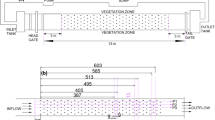Abstract
Neutral surface layer flow over low hills and varying surface roughness is considered with emphasis on closure schemes in relation to the prediction of turbulence quantities. The equations are linearised, Fourier transformed in the two horizontal directions and solved by means of a finite difference method in the vertical. Three closure schemes are. employed, namely mixing length, E-ɛ and e-ɛ-Τ closure where E, ɛ and Τ indicate that differential equations are used for turbulent kinetic energy, dissipation rate and shear stress. Model calculations are compared with experimental data for the step in roughness problem and for the Askervein hill. The mean flow results turn out to be relatively insensitive to the closure scheme. The shear stress and the dimensionless shear, however, are much better predicted with the E-ɛ equations than with mixing length closure. In the outer layer of the hill problem, advection of shear stress becomes important. An equation for Τ is needed here.
Similar content being viewed by others
References
Beljaars, A.C.M., Schotanus, P. and Nieuwstadt, F.T.M. (1983) ‘Surface layer similarity under nonuniform fetch conditions’ J. Clim. Appl. Meteorol., 22, 1800–1810.
Beljaars, A.C.M., Walmsley, J.L. and Taylor, P.A. (1987) ‘A mixed spectral finite-difference model for neutrally stratified boundary-layer flow over roughness changes and topography’, Boundary-Layer Meteorol., 38, 273–303.
Bradley, E.F. (1968) ‘A micrometeorological study of velocity profiles and surface drag in the region modified by a change in surface roughness’, Quart. J. Roy. Meteorol. Soc., 94, 361–379.
Bradley, E.F. (1980) ‘An experimental study of the profiles of wind speed, shearing stress and turbulence at the crest of a large hill’, Quart. J. Roy. Meteorol. Soc., 106, 101–123.
Claussen, M. (dy1987) ‘Models of eddy viscosity for numerical simulation of horizontally inhomogeneous neutral surface layer flow’, submitted to Boundary-Layer Meteorol.
Hunt, J.C.R. (1980) ‘Wind over hills’, In: Workshop on the planetary boundary layer (J.C. Wyngaard, Ed.) AMS, Boston, Ma., 107–149.
Jackson, P.S. and Hunt, J.C.R. (1975) ‘Turbulent wind flow over a low hill’, Quart. J. Roy. Meteorol. Soc., 101, 929–955.
Launder, B.E. (1975) ‘Progress in the modelling of turbulent transport’, Lecture notes presented at the Von Karman Institute, Rhode-St.-Genese, Belgium, March 3–7.
Mason, P.J. and Sykes, R.I. (1979) ‘Flow over an isolated hill of moderate slope’, Quart. J. Roy. Meteorol. Soc., 105, 383–395.
Orlanski, I. (1975) ‘A rational subdivision of scales for atmospheric processes’, Bull. Amer. Meteorol. Soc., 56, 527–530.
Panofsky, H.A. and Townsend, A.A. (1964) ‘Change of terrain roughness and the wind profile’, Quart. J. Roy. Meteorol. Soc., 90, 147–155.
Peterson, E.W. (1969) ‘On the relation between the shear stress and the velocity profile after a change in surface roughness’, J. Atmos. Sci., 26, 773–774.
Rao, K.S., Wyngaard, J.C. and Coté, O.R. (1974) ‘The structure of the two-dimensional internal boundary layer over a sudden change of surface roughness’, J. Atmos. Sci., 31, 738–746.
Rodi, W. (1980) Turbulece models and their applications in hydraulics: a state-of-the-art review, Inst. für Hydromechanik, Univ. of Karlsruhe, Germany.
Shir, C.C. (1972) ‘A numerical computation of air flow over a sudden change of surface roughness’, J. Atmos. Sci., 29, 304–310.
Taylor, P.A., Walmsley, J.L. and Salmon, J.R. (1983) ‘A simple model of neutrally stratified boundary layer flow over real terrain incorporating wavenumber-dependent scaling’, Boundary-Layer Meteorol., 26, 169–189.
Taylor, P.A. and Teunissen, H.W. (1985) The Askervein hill project: report on the September/October 1983 main field experiment, Internal Rep. MSRB-84–6, Atmos. Environ. Service, Downsview, Ont., Canada.
Tennekes, H. and Lumley, J.L. (1972) A first course in turbulence, MIT Press, Cambridge, Mass.
Townsend, A.A. (1965) ‘The response of a turbulent boundary layer to abrupt changes in surface conditions’, J. Fluid Mech., 22, 799–822.
Walmsley, J.L., Taylor, P.A. and Keith, T. (1986) ‘A simple model of neutrally stratified boundary-layer flow over complex terrain with surface roughness modulations (MS3DJH/3R)’, Boundary-Layer Meteorol., 36, 157–186.
Zeman, O. (1981) ‘Progress in the modeling of planetary boundary layers’, Ann. Rev.Fluid Mech., 13, 253–272.
Zeman, O. and Jensen, N.O. (1985) Response of the Reynolds stress tensor to the mean flow distortion over a two-dimenional hill, Seventh Symp. Turb. Diff., Amer. Meteorol. Soc., Nov. 12–15, Boulder, Co.
Zeman, O. and Jensen, N.O. (1987) ‘Modification of turbulence characteristics in flow over hills’, Quart. J. Roy. Meteorol. Soc., 113, 55–80.
Author information
Authors and Affiliations
Rights and permissions
About this article
Cite this article
Beljaars, A.C.M., Walmsley, J.L. & Taylor, P.A. Modelling of turbulence over low hills and varying surface roughness. Boundary-Layer Meteorol 41, 203–215 (1987). https://doi.org/10.1007/BF00120439
Issue Date:
DOI: https://doi.org/10.1007/BF00120439




